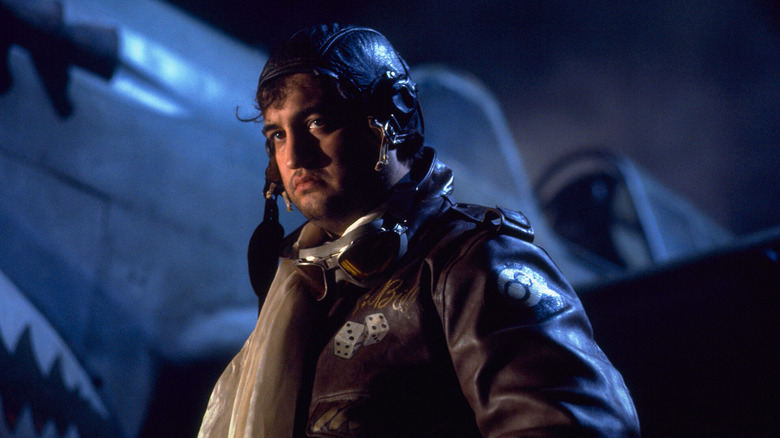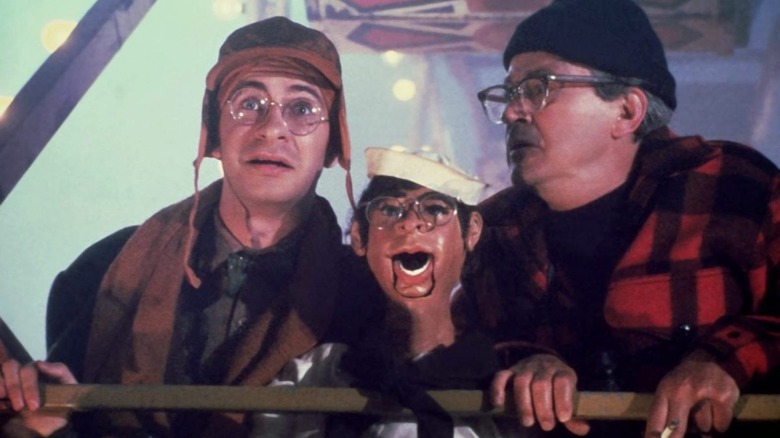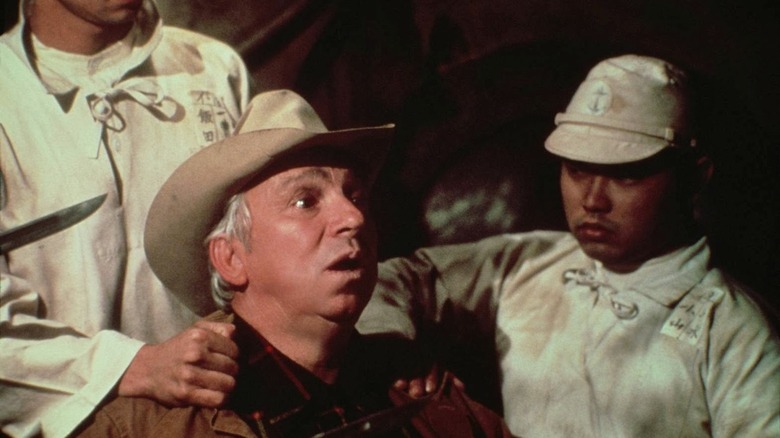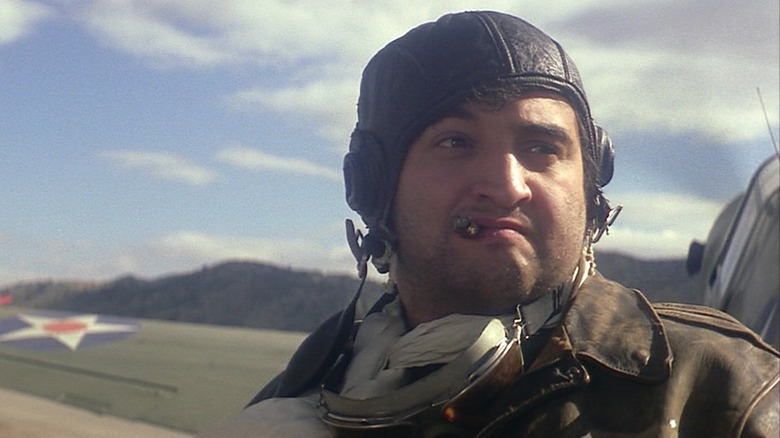Steven Spielberg Left A Lot Of 1941's 'Connective Tissue' On The Cutting Room Floor
Steven Spielberg's "1941" is one of the most blissfully chaotic movies ever made. It is obscenely expensive, narratively scatterbrained, and unabashedly irreverent about one of the most devastating acts of war ever carried out by a foreign nation on American soil. It's more of a model train set than a movie, one operated by a spoiled brat who'd rather send the cars soaring off the track into the basement wall than keep his meticulously constructed railroad running smoothly. Crammed somewhere in the movie is an unruly satire about self-destructive, run-amok jingoism, but it's also a live-action Looney Tunes cartoon where a runaway Army tank crashes through a paint factory and then a turpentine factory.
After the back-to-back blockbuster triumphs of "Jaws" and "Close Encounters of the Third Kind," Spielberg could call his tune at Universal, and he threw his all into this nutty World War II flick scripted by the up-and-coming screenwriting duo of Robert Zemeckis and Bob Gale. Studios had yet to figure out tried-and-true four-quadrant formulas in 1979, so they implicitly trusted the instincts of big-screen dream weavers like Spielberg, George Lucas, and Ridley Scott. The film was a hit, but it fell far short of Spielberg's previous two movies. He was fallible. Everyone learned a lesson on "1941," and I'm still not sure it was the right one.
Hollywood goes to war
In a 2014 interview with RogerEbert.com's Peter Sobczynski, Bob Gale opened up about the unrestrained scripting process that hooked Steven Spielberg:
"We were really young and exuberant and ignorant. We would think of this stuff and say 'Yeah, we could have a dogfight on Hollywood Boulevard — let's write that in!' or 'We could put riots on Hollywood Boulevard — let's do that!' or 'We could have a Ferris wheel roll down the Santa Monica pier — let's put that in there!' without ever thinking about how these images would or could be put on the screen."
All of the aforementioned is in the movie, and it broadly mirrors the societal upheaval that was roiling Los Angeles at the time. But as dutiful screenwriters, Robert Zemeckis and Gale felt obliged to give their major characters a minimal amount of backstory. The problem with "1941," however, is that it's never sure who qualifies as a major character. Bobby Di Cicco's Wally is the ostensible protagonist. He's an exuberant dishwasher at a roadside California eatery who dreams of dancing his way to movie stardom. He's madly in love with Betty Douglas (Dianne Kay), who becomes an object of obsession for the alarmingly aggressive Corporal Chuck Sitarski. So there's your love triangle.
A dark comedy about America on the eve of its finest hour
But here's the problem: Steven Spielberg decided to ride the "Saturday Night Live" wave, and cast John Belushi as renegade pilot Wild Bill Kelso. "1941" hit theaters one year after "National Lampoon's Animal House," and Spielberg, in his crowd-pleasing prime, leaned heavily on Belushi for big laughs. Is Belushi funny in the movie? Yes, but only because his outsized antics match the overblown nature of the movie. He yells a lot. He blows up a gas station in a pistol-popping rage because his Curtiss P-40 Warhawk drifts away from the pump. His scene with Warren Oates' Colonel "Mad Man" Maddox, who heads up a misfit-laden bomb disbursement unit in Barstow, is the hardest I've ever laughed at a comedic scene devoid of a punchline. Seriously, there are no jokes. It's only funny because Maddox inexplicably demands to hear Kelso fire his guns. Kelso obliges, and somehow, despite the crippling damage inflicted on Maddox's operation, no one gets killed.
According to Bob Gale, the film was "flawed" because "the backstories of the characters and the connective tissues of the story ended up on the cutting room floor." This was remedied with a reconstructed version released to home video and 1980, which was expanded for LaserDisc in 1995. "1941" exploded to 146 minutes, and while it was nice to see Slim Pickens engage in a labored bit of physical comedy prior to getting hauled onto Toshiro Mifune's submarine, the joy of Spielberg's film is that a lot of inexplicable things happen at once. Pickens is only there for a dumb sight gag and a callback to Stanley Kubrick's "Dr. Strangelove."
Gonzo Spielberg is great Spielberg
The theatrical cut of "1941" is propelled by a boisterous logic that is exhilarating to some and exhausting to others. For me, it's a war-torn riff on Stanley Kramer's "It's a Mad, Mad, Mad, Mad World." It's also the film that, on the strength of its dazzling USO dance/fight sequence, made me desperate for a Spielberg-directed musical (which he nailed with "West Side Story"). Spielberg and his longtime editor Michael Kahn zeroed in on the madness of the endeavor the first time through and didn't turn it into the misfire its detractors claimed it was until they inserted that judiciously cut half-hour of footage.
"1941" is an untamed masterpiece from a generational wunderkind who had the run of the biggest candy factory on the planet. It's not my favorite Spielberg film, but I think it's every bit as entertaining as "Jaws" and "Raiders of the Lost Ark." It's a carte-blanche, let-me-hear-your-guns classic. Every great filmmaker should get to make their "1941."



